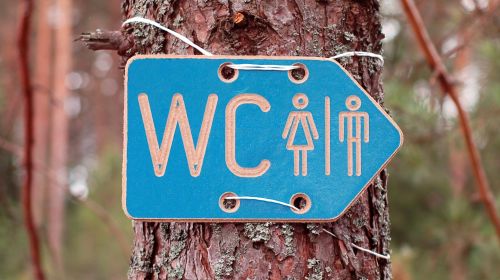Bladder stones are deposits that form in the bladder from crystals. In most cases, bladder drainage problems are the cause, rarely are kidney stones that have been flushed into the bladder with the urine. The symptoms are significantly less dramatic than with kidney stones, but bladder stones sometimes need to be removed surgically.
- Bladder stones are undesirable deposits in the bladder. They can grow as big as a chicken egg.
- © iSzock.com/transurfer
Bladder stones are deposits in the bladder (concretions) that are made up of urine components and can be as big as a chicken egg. They belong to the group of urinary stones, which, depending on their position, are divided into kidney stones, ureteral stones and bladder stones. Bladder stones are particularly common in older men and overweight people.
Overview of article content:
The symptoms of bladder stones
Whether and in what form symptoms develop with bladder stones depends on the size, position and mobility of the bladder stones. If a bladder block closes the urinary bladder outlet, the urine builds up temporarily. This means that it is often not possible to urinate continuously, although the person affected still feels the urge to do so.
In some cases, the bladder stones irritate the bladder mucosa and even cause inflammation. In these cases, pain occurs in the lower abdomen, in the genital organs up to the back. A burning sensation when urinating and blood in the urine can also indicate bladder stones. In some cases, those affected also complain of bladder cramps or a foreign body sensation in the bladder.
What causes bladder stones?
When it comes to the causes of bladder stones, a distinction is made between primary and secondary bladder stones. Secondary bladder stones are deposits that have formed in another organ, such as a kidney, and which enter the bladder through the ureters. Secondary bladder stones are far less common than primary bladder stones because the stones that have entered the bladder are often simply flushed out through the urethra.
One speaks of primary bladder stones if the deposits develop directly in the bladder through the crystallization of special salts. If the salt in question has too high a concentration, it first forms a small lump on which more and more layers are deposited over time. As a result, the so-called concrement grows and gets bigger and bigger.
In most cases, blockage of the bladder outlet or urethra is responsible for the development of bladder stones. With such a drainage disorder, the bladder cannot be completely emptied, the urine remains disproportionately long in the bladder and crystals are formed.
An enlarged male prostate is often the trigger for a urinary drainage disorder. Scars after surgery can also cause the urethra to narrow. Rarely is there a tumor or spinal cord damage in which the muscles of the bladder are paralyzed. Due to anatomical malformations, urinary drainage can also be disturbed in children in rare cases.
Other potential triggers for bladder stones are:
frequent bladder infections
incorrect drinking behavior (insufficient fluid intake)
improper nutrition (with lots of animal fats and proteins)
severely restricted physical movement (e.g. long, illness-related lying)
Foreign body in the bladder (such as a bladder catheter)
Metabolic disorders (e.g. overactive thyroid)
congenital metabolic diseases (e.g. cystinuria)
Examinations and diagnosis of bladder stones
If bladder stones are suspected, a urologist is the right contact. In a detailed discussion, the patient will first inquire about symptoms, medical history and lifestyle habits. The doctor can often assess the risk of developing bladder stones based on the person's eating habits and living conditions.
This is followed by a physical examination of the abdomen, kidneys and (in men) prostate. Blood and urine samples are also taken and analyzed in the laboratory. An ultrasound examination (sonography) can detect some bladder stones and examine the bladder for remaining urine.
This may be followed by further examinations, some of which are carried out by the specialist. In addition to computed tomography, urography is used here, in which the excretion of urine is checked from the kidneys to the urethra using contrast media.
Bladder mirroring (cystoscopy) can also provide information about any existing bladder stones. A thin tube is inserted into the urethra and a camera is attached to the end. This enables the stones to be assessed in terms of size, number and location, but also to identify other possible causes for the blockage of urine flow.
Another method of examination is retrograde urography. A contrast medium is introduced into the ureter so that the bladder and ureter as well as possible stones can be displayed plastically.
Treatment of bladder stones: There are these therapy options
The type of treatment of the bladder stones depends on their composition, their size and nature as well as their location. In this way, small stones can be literally washed out by an increased hydration – mostly in connection with antispasmodic and analgesic medication.
Another way to remove the bladder stones is to dissolve them by administering medication (litholysis). Larger stones are located using an ultrasound examination and then crushed by shock waves so that they can be excreted in the urine.
In some cases, it is necessary to surgically remove the bladder stones. This procedure is performed through the urethra and is called transurethral lithotripsy. Alternatively, access can also be via the abdominal wall: In this procedure, known as percutaneous cystolithotomy, a thin channel is placed from the outside with the help of a puncture needle up to the bladder, through which the bladder stones can be broken and removed.
Open surgery to remove bladder stones is now very rare and only carried out when the minimally invasive procedures mentioned cannot be used. This can be the case, for example, if the doctor does not get into the bladder during the bladder examination because it is blocked by the stone.
Course of the disease and prognosis in bladder stones
In most cases, bladder stones are automatically flushed out with the urine or can be removed easily. If left untreated, they can cause recurrent bladder infections and kidney damage, and can also increase the risk of bladder cancer.
Without suitable aftercare, around 50 percent of those affected experience at least one, and up to 25 percent even three or more stone recurrences (renewed stone formation). It is therefore important to eliminate the cause of the bladder stones.
This is how you can prevent bladder stones
Because an enlarged prostate is one of the most common causes of bladder stone formation, treating it is an important preventive measure. The same applies to the early and consistent treatment of cystitis, which can also lead to the formation of urinary stones. In addition, the risk of blistering can be significantly reduced with simple home remedies.
Adequate hydration is important to prevent the formation of bladder stones. At least two and a half to three liters of water, unsweetened herbal and fruit tea should be drunk throughout the day. However, the consumption of black tea, coffee and alcohol should be restricted.
After a bladder stone removal, it may also make sense to change your diet to low-meat and low-fat foods. Depending on the composition of the bladder stones found, certain foods should be avoided:
If calcium oxalate stones are responsible for the suffering, a reduced oxalate intake is recommended. For example, rhubarb, black tea, spinach, cocoa and nuts contain oxalic acid.
If it is uric acid stones, excess weight should be reduced and the purine and protein intake reduced. This means that meat and sausages, offal, seafood and alcohol are largely avoided.


